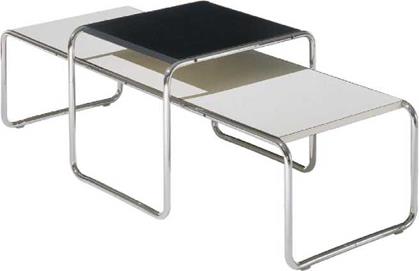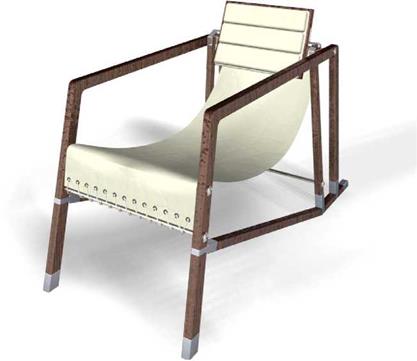Walter Gropius (1883-1969) founded the Bauhaus school in Dessau, Germany, in 1919. It precipitated a revolution in art, design, and architectural education whose influence is still felt today. In the words of Wolf von Eckardt, the Bauhaus "created the patterns and set the standards of present-day industrial design; it helped to invent modern architecture; it altered the look of everything from the chair you are sitting on to the page you are reading now."12 Under Gropius’s leadership, design and furniture created a modernist revolution demonstrating how materials and fabrication processes could inspire the design process. An example of this philosophical approach can be seen in Mart Stam’s design of the first cantilevered tubular steel chair.
Ludwig Mies van der Rohe (1886-1969) was one of the defining figures of twentieth – century design. He designed the Barcelona Pavilion and the famous Barcelona chair in 1928 (Figure 10.57). The chair became a classic, though it was not conducive to mass production because of the hand welding that was required for the side supports. It is also a remarkably heavy chair, weighing 84 pounds (38 kilos), due to the stainless steel supports and foam
rubber cushions, making distribution expensive. Mies produced his Brno chair (1929-1930) for the Tugendhat house in Brno, Czech Republic. Both the chair and the residence used similar fabrication techniques, which derived from similar design processes. Between 1930 and 1933, Mies was the director of architecture at the Bauhaus before moving to Chicago to teach at the Illinois Institute of Technology in 1938. The Knoll Group still produces his complete line of furniture.
 Marcel Breuer (1902-1981) was one of the most influential twentieth-century furniture designers. Breuer studied art in Vienna before enrolling at the Bauhaus in 1920.
Marcel Breuer (1902-1981) was one of the most influential twentieth-century furniture designers. Breuer studied art in Vienna before enrolling at the Bauhaus in 1920.
There he studied furniture under Walter Gropius. Before setting up his own practice in Berlin in 1926, he designed the famous Wassily chair and the B32, popularly referred to as the Cesca chair, as well as a series of nesting tables (Figure 10.58). The Laccio side table was originally intended to be used as a stool for the cafeteria at the Bauhaus.
Before World War II, Breuer followed Gropius to the United States and taught at the Harvard Graduate School of Design. He also set up an architectural practice in Cambridge, Massachusetts, and worked on many architectural commissions for the next 20 years. In 1960, the Italian
company Gavina revived production of a number of his furniture pieces from the 1920s, and recently Knoll Studio produced several of his designs, reviving his contribution to modern furniture design almost half a century later.
Eileen Gray (1878-1976), an Irish-born designer and architect, was one of a handful of women who influenced the course of modern design. Her early work in Paris revealed Art Deco styling, but after 1922 her designs emulated the influence of de Stijl, cubism, and eventually modernist theories. Three of her more modernist works are the Blocs Screen (see Chapter 4), a lacquered screen with pivoting panels (1922), the Transat chair (a lacquered
 Figure 10.58 Laccio; nesting tables with tubular steel frames, designed by Marcel Breuer (1925). Manufactured by Knoll International. 215/8 inches wide; 187/8 inches deep; 17% inches high (55 cm wide; 48 cm deep; 45 cm high). Photography courtesy of Knoll, Inc.
Figure 10.58 Laccio; nesting tables with tubular steel frames, designed by Marcel Breuer (1925). Manufactured by Knoll International. 215/8 inches wide; 187/8 inches deep; 17% inches high (55 cm wide; 48 cm deep; 45 cm high). Photography courtesy of Knoll, Inc.
|

wood frame, metal hardware, leather-upholstered chair) designed between 1925 and 1927 (Figure 10.59), and several versions of a cantilevered and adjustable tubular steel frame bedside table with a glass top (1925-1928).



